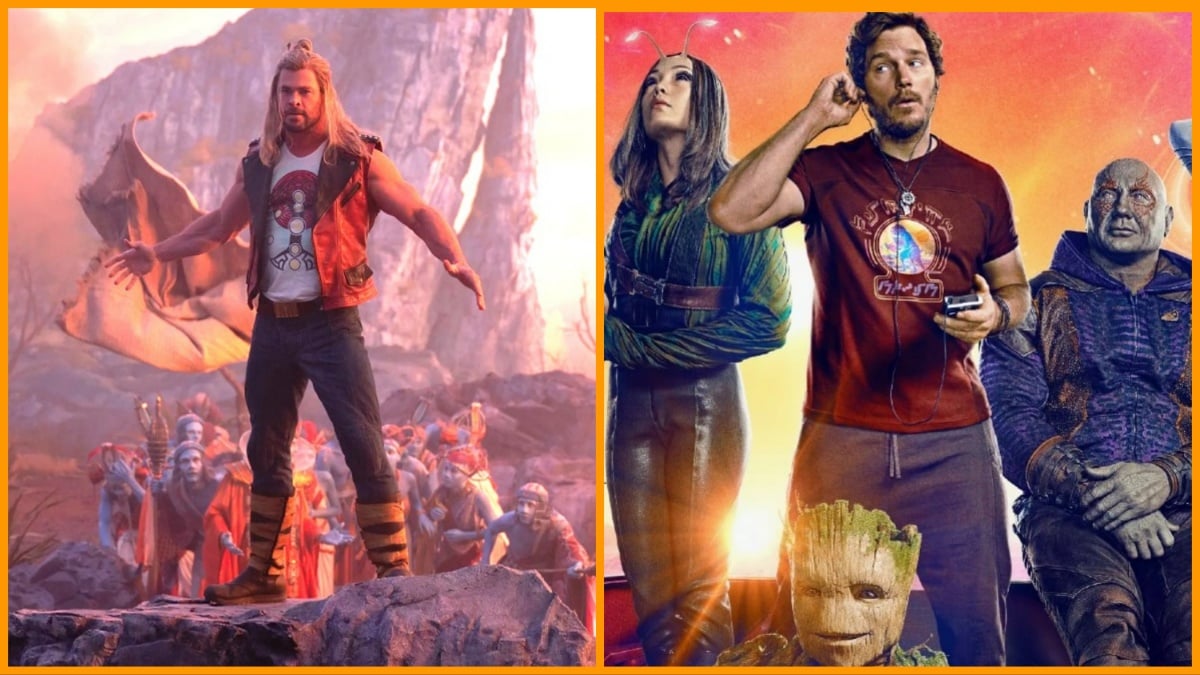Warning: This article contains spoilers for Guardians of the Galaxy Vol. 3.
Released roughly a year apart, Guardians of the Galaxy Vol. 3 and 2022’s Thor: Love and Thunder are perfect examples of how all over the place the MCU’s Multiverse Saga has been in terms of perceived quality. While Taika Waititi’s second Marvel effort languishes as one of the lesser-reviewed franchise entries, Guardians 3 isn’t exactly critically acclaimed, but fans can’t stop praising its highly emotional and dramatically satisfying conclusion to the cosmic team’s story arc.
Despite the Guardians cameoing in Love and Thunder, Vol. 3 even goes out of its way to ignore the Chris Hemsworth vehicle, suggesting James Gunn isn’t too pleased with how Waititi handled his characters. If so, that’s kind of ironic given that Gunn appears to have accidentally copied Waititi’s homework himself. After seeing Guardians 3, I walked out of the theater filled with appreciation for what Gunn had achieved with his MCU farewell. But then it hit me — wait, did he just trick me into seeing Love and Thunder again?
It’s true, Guardians 3 and Thor 4 are essentially the same story. And here are the receipts to prove it.
Spot the Difference: Thor/Star-Lord edition
Peter Quill and Thor Odinson didn’t exactly get on in Avengers: Infinity War and Endgame, but their arcs in their most recent movies are pretty much identical. For instance, here’s a summation of how one of these heroes begins their film. Try and guess which one I’m talking about:
The protagonist, who has lost both of his parents in previous movies and recently found out he has a long-lost sister, starts out sad over the loss of his ex-girlfriend, only to have a surprise re-encounter with their loved one in a new form that takes place after the hero’s homebase is attacked by a dangerous new enemy.
So is this about Star-Lord or Thor? Trick question, it’s both. By the beginning of Vol. 3/LaT, Quill and Thor are both orphans with surprise siblings (Hela/Mantis) and are missing Gamora/Jane, only to reunite with them once they’ve undergone a change (Jane is Thor/Gamora is her past self) after Adam Warlock trashes Knowhere/during Gorr’s siege on New Asgard.
Gorr was butchered, but the High Evolutionary gets praised?
Despite Christian Bale’s spot-on casting as the deity-defying foe, Gorr the God-Butcher was wildly agreed to be a wasted opportunity to create a tantalizing new MCU villain. Meanwhile, Chukwudi Iwuji’s High Evolutionary has been broadly acclaimed. In many ways, though, they are flip sides of the same character.
For starters, both have delusions of grandeur. While Gorr believes he can kill every god, the High Evolutionary wants to be god. More specifically, both of their plans involve locking up children — Gorr kidnaps the children of New Asgard while the HE has an ark ship full of his genetically engineered perfect specimens.
This means that the motivation and framing of the movies’ third acts are somewhat similar, as they involve the heroes storming the villain’s base to free the kids from harm.
Love saves the day, but it doesn’t last
The most fundamental comparison to be made between LaT and Guardians 3, however, is their shared ultimate message that love and compassion are paramount, even if romantic love is fleeting.
Despite being reunited with their lost loves, neither Quill nor Thor get what they were dreaming of at the film’s beginning, due to Jane succumbing to her cancer and entering the afterlife of Valhalla and Gamora II simply being too different from Gamora I to remain at Peter’s side. Nevertheless, both move forward with hope and a deeper sense of empathy. Thor adopts Love while Quill steps aside to allow Rocket to lead the next generation of Guardians (Phyla-Vell is even comparable to Love).
What’s more, another character emphasizes this theme by doing a last-minute about-turn to the side of the angels that is honestly a little too abbreviated to be entirely believable. Gorr sacrifices his own life to resurrect Love while Adam Warlock puts himself at risk to selflessly save Star-Lord.
On the other hand, the big difference between Gunn and Waititi’s films is how much these themes resonate with the audience by the time the credits roll. For whatever reason, be it Love and Thunder‘s over-reliance on goofy humor or Vol. 3‘s commitment to playing it straight, many fans would say there’s one clear winner in this regard. It just goes to show, it’s how you tell a story that really matters.
